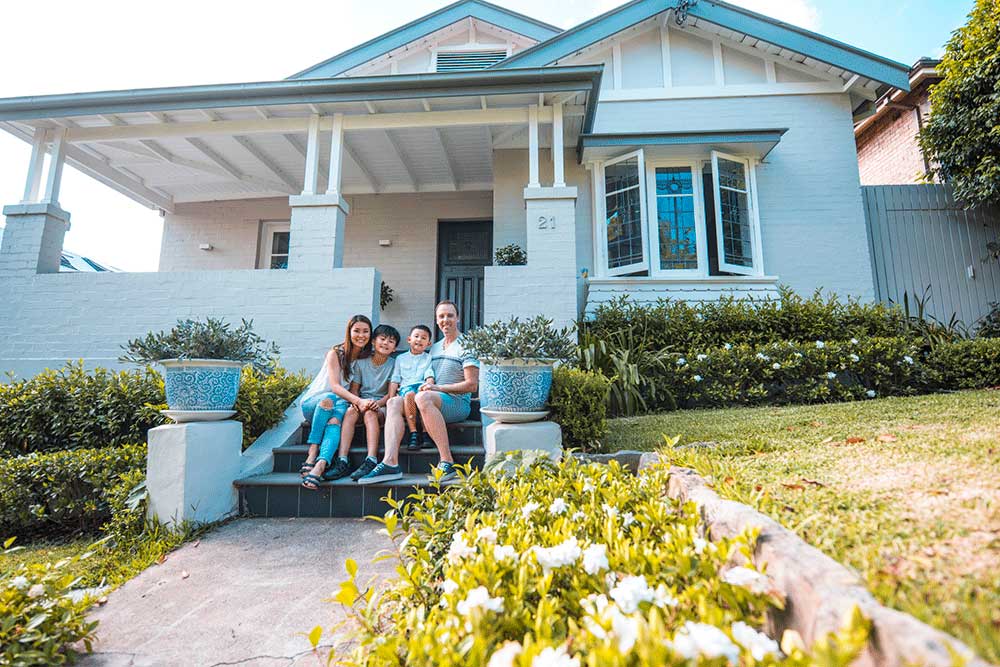How much should I insure my house for?

How much to insure a house for, plus tips to avoid underinsurance
Many people assume that having home insurance means they’re fully protected, but that’s not always the case. You could be underinsured without even realising it. What does that mean? Simply put, it means your insured amount may not be enough to rebuild or replace your home and belongings if disaster strikes. Your home is one of your biggest investments, and if your coverage falls short, you could be left paying the difference yourself. Having your home insured for the correct amount can mean the difference between financial security or financial setback.
To help you determine whether your home is insured for an appropriate amount, we’ve gathered information and tips in this resource for you to consider. Keep reading to see whether your current insurance is adequate for your situation.
In this article, you will learn:
- Key takeaways
- How to determine the right sum insured for your home
- The risks of underinsurance
- Key steps to ensure your home and belongings are properly insured
- Practical tips for choosing the right cover amount
- Why underinsurance is a growing concern in Australia
Key takeaways
- The sum insured should reflect the cost to rebuild your home, not its market value.
- Underinsurance is common in Australia and can leave many homeowners financially vulnerable.
- Estimating rebuild and replacement costs accurately helps ensure adequate coverage.
- Using home insurance calculators and professional valuations can improve accuracy.
- Regularly reviewing and updating your sum insured amount is essential, especially as building costs rise.
- Tenants should also consider contents insurance to protect their belongings.
How much should I insure my home for? Determining ‘sum insured’
The sum insured is the maximum amount your insurer will pay (less any applicable excess) to rebuild your home if it’s damaged or destroyed. This is the figure that you will agree to when you take out a home building insurance policy.
Keep in mind that sum insured is different from the market value of your home since the market value includes land value and real estate demand factors. The sum insured is only related to rebuilding costs.
When choosing a sum insured amount, make sure that the amount reflects:
- The rebuild cost of your home, including materials and labour
- Additional features like swimming pools, garages and sheds
Because construction costs can change over time, you should review your sum insured each year at renewal. Keeping it up to date helps ensure you have enough cover to rebuild if the unexpected happens.
If you don’t know how to calculate these figures yourself, don’t worry, the following section shows you how to estimate these numbers.
How to avoid underinsurance for your home and belongings
As mentioned before, being underinsured can create serious financial stress if your policy doesn’t cover the full cost of rebuilding after a disaster like a fire, flood, or storm. Many homeowners underestimate how much it actually takes to rebuild.
The following methods for estimating your sum insured will help you reach a more accurate figure.
How to estimate your rebuild cost:
- Use online home insurance calculators like the one provided by RACQ.
- Get a professional rebuild valuation for your house. This may be an options for high value homes. A qualified building surveyor or quantity surveyor can offer a tailored estimate based on your property’s unique features.
How to estimate replacement value for your personal belongings
- Use a home contents calculator like the one provided by RACQ.
- Take a home inventory, including receipts and photographs and update your list regularly, especially after making big purchases. This should include:
- Large essentials: fridge, beds, couches, washing machines
- Electronics: TVs, laptops, gaming consoles
- Valuables: jewellery, artwork, designer handbags
5 key steps to ensure your home insurance covers what you need
Here are five key steps to help you avoid underinsurance and ensure your home and belongings are adequately covered.
1. Review your sum insured amount every year
Building costs can increase, and any renovations or upgrades may change the value of your home. Reviewing your insurance annually helps ensure your coverage keeps up with these changes.
2. Choose the right policy and add-ons for your needs
Not all policies offer the same level of coverage. Compare home insurance policy options and consider whether you need cover for things like:
- Accidental damage
- Mobile phones
- Specified items you want to list individually
3. Keep an inventory list and review replacement values annually
While your insurance may not require this, keeping a home inventory can help you estimate a suitable sum insured and make the claims process easier. If you do have specified items on your policy, you’ll need to revalue them each year at renewal to keep your cover up to date.
4. Renters should consider contents insurance too
Even if you don’t own your home, contents insurance can protect your valuables from theft, loss, or accidental damage.
5. Always read the PDS to understand your coverage
Your Product Disclosure Statement (PDS) outlines what is and isn’t covered. Reviewing it carefully can help you avoid surprises when you need to make a claim.
Is underinsurance a problem in Australia?
Yes, underinsurance is a widespread issue in Australia. Many homeowners are unknowingly underinsured, which can leave them financially exposed. Studies show that:
- A significant portion of Australians are cutting back on insurance due to rising living costs, leaving them unprotected during extreme weather events.
- Climate change is increasing risks, with bushfires, floods, and cyclones causing more property damage than ever before.
- Building costs have risen, making previous sum insured amounts insufficient for full rebuilds today.
Taking the time to calculate an accurate sum insured amount can prevent serious financial strain if disaster strikes.
Protect what matters the most
Having the right home insurance cover amount can make all the difference if disaster strikes. By reviewing your sum insured regularly, understanding your policy options, and ensuring your coverage reflects the true value of your home and belongings, you can protect yourself from financial hardship.
Take the time to assess your coverage today and make sure you have the protection you need. If you're unsure, use one of our online calculators or speak with RACQ to get the right level of cover for your home.
Related topics
Things to note
The information in this article has been prepared for general information purposes only and is not intended as legal advice or specific advice to any particular person. Any advice contained in the document is general advice, not intended as legal advice or professional advice and does not take into account any person’s particular circumstances. Before acting on anything based on this advice you should consider its appropriateness to you, having regard to your objectives and needs.
Insurance Products (excluding Travel Insurance) are issued by RACQ Insurance Limited ABN 50 009 704 152 (RACQI) and arranged by its agent, RACQ Distribution Services Pty Ltd (RDS) ABN 35 116 361 650, AFSL 567130 and RDS' authorised representatives (including RACQ Operations Pty Ltd ABN 80 009 663 414, AR No. 234978 (RACQO). Conditions, limits and exclusions apply. RDS and RACQO are in the RACQ group of companies. One of the companies in the RACQ group of companies has a minority shareholding in RACQI.
RDS and RACQO have not taken your personal objectives, circumstances or needs into account when preparing advice regarding insurance products and you will need to consider whether the advice is appropriate for you. Read the Product Disclosure Statement (PDS) and any applicable Supplementary PDS before making a purchase decision on this product. You can also access our Target Market Determinations on this website. RDS receives a commission from RACQI for the policies it arranges. RACQO receives fees paid for services it provides to RDS. Further details about remuneration are available on request prior to purchasing.
Banking and loan products issued by Members Banking Group Limited ABN 83 087 651 054 AFSL/Australian credit licence 241195 trading as RACQ Bank. Terms, conditions, fees, charges and lending policies apply. This is general advice only and may not be right for you. This information does not take your personal objectives, circumstances or needs into account. Read the disclosure documents for your selected product or service, including the Financial Services Guide and the Terms and Conditions, and consider if appropriate for you before deciding.
Except for RACQ Bank, any RACQ entity referred to on this page is not an authorised deposit-taking institution for the purposes of the Banking Act 1959 (Cth). That entity’s obligations do not represent deposits or other liabilities of RACQ Bank. RACQ Bank does not guarantee or otherwise provide assurance in respect of the obligations of that entity, unless noted otherwise.
RACQ Bank subscribes to the Customer Owned Banking Code of Practice which establishes higher standards than the law requires. The Code reflects modern consumer expectations and developments in approaches to issues such as consumer vulnerability, guarantors, and supporting customers through financial hardship. Please read our Customer Owned Banking Code of Practice page for more information.
RACQ Operations Pty Ltd (ABN 80 009 663 414 AR 000234978) and Members Travel Group Pty Ltd (ABN 45 144 538 803 AR 000432492) are acting as an Authorised Representative of the issuer of the insurance, Tokio Marine & Nichido Fire Insurance Co., Ltd. (ABN 80 000 438 291 AFSL 246 548). Any advice set out above is general in nature only, and does not take into account your objectives, financial situation or needs. Before purchasing any travel products, please consider the RACQ Travel Insurance Product Disclosure Statement (PDS) and the Target Market Determinations (TMDs) that apply to these products. Whilst the PDS outlines the Terms and Conditions of these products, the TMDs outline the intended class of customers that comprise the target market for these travel products. This will allow you to consider which products best suit your objectives, financial situation and needs and consider the products appropriateness to your personal circumstances. TMDs also outline matters involving the distribution and the review of these products. The PDS, Supplementary PDS and TMDs for each travel product can be found here.
